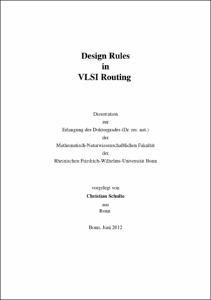Design Rules in VLSI Routing

Design Rules in VLSI Routing

| dc.contributor.advisor | Vygen, Jens | |
| dc.contributor.author | Schulte, Christian | |
| dc.date.accessioned | 2020-04-18T00:53:33Z | |
| dc.date.available | 2020-04-18T00:53:33Z | |
| dc.date.issued | 17.08.2012 | |
| dc.identifier.uri | https://hdl.handle.net/20.500.11811/5367 | |
| dc.description.abstract | One of the last major steps in the design of highly integrated circuits (VLSI design) is routing. The task of routing is to compute disjoint sets of wires connecting different parts of a chip in order to realize the desired electrical connectivity. Design rules define restrictions on the minimum distance and geometry of metal shapes. The intent of most design rules is to forbid patterns that cannot be manufactured well in the lithographic production process. This process has become extremely difficult with the current small feature sizes of 32 nm and below, which are still being manufactured using 193 nm wavelength technology. Because of this, the design rules of modern technologies have become very complex, and computing a routing with a sufficiently low number of design rule violations is a difficult task for automated routing tools. In this thesis we present in detail how design rules can be handled efficiently. We develop an appropriate design rule model which considerably reduces complexity while not being too restrictive. This involves mapping complex polygon-based rules to simpler rectangle-based rules and building equivalence classes of shapes with respect to their minimum distance requirements. Our model enables efficient checking of minimum distance rules, which has to be done dozens of times in each routing run. We also discuss efficient data structures that are necessary to achieve this. We implemented our design rule model within BonnRoute, the routing tool of the BonnTools, a software package for VLSI physical design developed at the Research Institute for Discrete Mathematics at the University of Bonn in cooperation with IBM. The result is a new module of BonnRoute, called BonnRoutRules, which computes this design rule model and embeds BonnRoute in the complex routing environment of current technologies. The BonnRouteRules module was a key part in enabling BonnRoute to route current 32 nm and 22 nm chips. We describe the combined routing flow used by IBM in practice, in which BonnRoute solves the main routing task and an industrial standard router is used for postprocessing. We present detailed experimental results of this flow on real-world designs. The results show that this combined flow produces routings with almost no remaining design rule violations, which proves that our design rule model works well in practice. Furthermore, compared to the industrial standard router alone, the combination with BonnRoute provides several significant benefits: It has 24% less runtime, 5% less wiring length, and over 90% less detours, which shows that with this flow we have an excellent routing tool in practice. | en |
| dc.language.iso | eng | |
| dc.rights | In Copyright | |
| dc.rights.uri | http://rightsstatements.org/vocab/InC/1.0/ | |
| dc.subject | Chipdesign | |
| dc.subject | Verdrahtung | |
| dc.subject | Regeln | |
| dc.subject | Modell | |
| dc.subject | Konvertierung | |
| dc.subject | VLSI Design | |
| dc.subject | BonnTools | |
| dc.subject | Routing | |
| dc.subject | Rules | |
| dc.subject | Model | |
| dc.subject | Conversion | |
| dc.subject.ddc | 004 Informatik | |
| dc.title | Design Rules in VLSI Routing | |
| dc.type | Dissertation oder Habilitation | |
| dc.publisher.name | Universitäts- und Landesbibliothek Bonn | |
| dc.publisher.location | Bonn | |
| dc.rights.accessRights | openAccess | |
| dc.identifier.urn | https://nbn-resolving.org/urn:nbn:de:hbz:5n-29521 | |
| ulbbn.pubtype | Erstveröffentlichung | |
| ulbbnediss.affiliation.name | Rheinische Friedrich-Wilhelms-Universität Bonn | |
| ulbbnediss.affiliation.location | Bonn | |
| ulbbnediss.thesis.level | Dissertation | |
| ulbbnediss.dissID | 2952 | |
| ulbbnediss.date.accepted | 07.08.2012 | |
| ulbbnediss.fakultaet | Mathematisch-Naturwissenschaftliche Fakultät | |
| dc.contributor.coReferee | Korte, Bernhard |
Files in this item
This item appears in the following Collection(s)
-
E-Dissertationen (4384)




